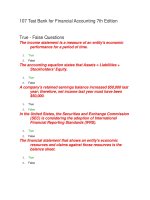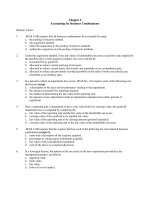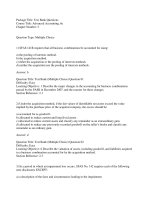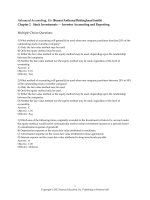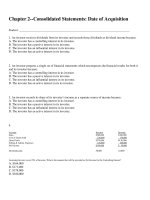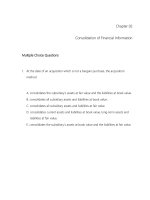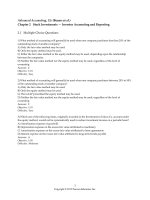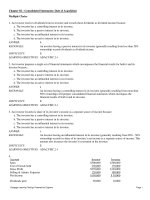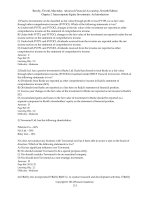Advanced financial accounting 7th edition beechy test bank
Bạn đang xem bản rút gọn của tài liệu. Xem và tải ngay bản đầy đủ của tài liệu tại đây (1.34 MB, 32 trang )
Beechy, Trivedi, MacAulay Advanced Financial Accounting, Seventh Edition
Chapter 2 Intercorporate Equity Investments: An Introduction
1) Passive investments can be classified as fair value through profit or loss (FVTPL) or as fair value
through other comprehensive income (FVTOCI). Which of the following statements is true?
A) Under both FVTPL and FVTOCI, changes in the fair value of the investment are reported as other
comprehensive income on the statement of comprehensive income.
B) Under both FVTPL and FVTOCI, changes in the fair value of the investment are reported under the net
income section on the statement of comprehensive income.
C) Under both FVTPL and FVTOCI, dividends received from the investee are reported under the net
income section on the statement of comprehensive income.
D) Under both FVTPL and FVTOCI, dividends received from the investee are reported as other
comprehensive income on the statement of comprehensive income.
Answer: C
Page Ref: 28
Learning Obj.: 2.2
Difficulty: Moderate
2) Rudd Ltd. has a passive investment in Burke Ltd. Rudd has elected to treat Burke as a fair value
through other comprehensive income (FVTOCI) investment under IFRS 9 Financial Instruments. Which of
the following statements is true?
A) Dividends from Burke are reported as other comprehensive income in Rudd's statement of
comprehensive income (SCI).
B) Dividends from Burke are reported as a line item on Rudd's statement of financial position.
C) Year-to-year changes in the fair value of the investment in Burke are reported as net income in Rudd's
SCI.
D) Accumulated gains and losses in the fair value of investment in Burke should be reported as a
separate component in Rudd's shareholders' equity on the statement of financial position.
Answer: D
Page Ref: 28
Learning Obj.: 2.2
Difficulty: Moderate
3) Townsend Ltd. has the following shareholders:
Palermo Co.—60%
Nix Ltd.—30%
Riley Ltd.—10%
Nix does not conduct any business with Townsend; nor has it been able to secure a seat on the board of
directors. Which of the following statements is true?
A) Nix has significant influence over Townsend.
B) Nix should consider Townsend to be a special purpose entity.
C) Nix should consider Townsend to be an associated company.
D) Nix should treat Townsend as a non-strategic investment.
Answer: D
Page Ref: 30-32, 35
Learning Obj.: 2.1
Difficulty: Moderate
4) O'Reilly Ltd. incorporated O'Reilly R&D Co. to conduct research and development activities. O'Reilly
Copyright © 2014 Pearson Canada Inc.
2-1
Beechy, Trivedi, MacAulay Advanced Financial Accounting, Seventh Edition
Chapter 2 Intercorporate Equity Investments: An Introduction
R&D is a(n) ________.
A) associated company
B) joint venture
C) structured entity
D) passive investment
Answer: C
Page Ref: 32-33
Learning Obj.: 2.1
Difficulty: Easy
5) What is securitization?
A) It is the process of issuing long-term debt for financing.
B) It is the process of issuing preferred and common shares for financing.
C) It is the process of transferring long-term liabilities to a structured entity.
D) It is the process of transferring receivables to a structured entity and issuing securities to finance those
receivables.
Answer: D
Page Ref: 33
Learning Obj.: 2.2
Difficulty: Easy
6) In Canada, what entities must be included in consolidated financial statements?
A) Subsidiaries only
B) All subsidiaries, except for ones in unrelated industries
C) All domestic subsidiaries
D) All subsidiaries and structured entities
Answer: D
Page Ref: 33-34
Learning Obj.: 2.2
Difficulty: Moderate
7) Bela Ltd. has invested in several domestic manufacturing corporations. Which of the following
investments would most likely be accounted for under the equity method on Bela's financial statements?
A) A holding of 15,000 of the 50,000 outstanding common shares of Earthwise Co.
B) A holding of 3,000 of the 10,000 outstanding preferred shares of Earthbent Co.
C) A holding of 5,000 of the 60,000 outstanding common shares of Earth-Kind Co.
D) A holding of 20,000 of the 25,000 outstanding common shares of Earth-Clean Co.
Answer: A
Page Ref: 35-36
Learning Obj.: 2.1
Difficulty: Easy
Copyright © 2014 Pearson Canada Inc.
2-2
Beechy, Trivedi, MacAulay Advanced Financial Accounting, Seventh Edition
Chapter 2 Intercorporate Equity Investments: An Introduction
8) On January 1, 20X1, Best Décor Ltd. started Chic Styles Ltd. by contributing $500,000 and received
100% of the common shares of Chic Styles. Chic Styles reported net income of $50,000 in 20X1 and $75,000
in 20X2 and paid out 40% of its net income as dividends in each year. Under the equity method, what
amount should be reported as Investment in Chic Styles and Investment Income on Best Décor's separateentity 20X2 financial statements?
A)
Investment in Chic Styles Investment Income
$500,000
$30,000
B)
Investment in Chic Styles
$575,000
Investment Income
$75,000
C)
Investment in Chic Styles
$625,000
Investment Income
$30,000
D)
Investment in Chic Styles
$625,000
Investment Income
$75,000
Answer: B
Page Ref: 36
Learning Obj.: 2.2
Difficulty: Moderate
9) Townsend Ltd. has the following shareholders:
Palermo Co.—60%
Nix Ltd.—30%
Riley Ltd.—10%
Nix has two seats on Townsend's five-person board of directors. Which of the following statements is
true?
A) Nix has significant influence over Townsend.
B) Nix has control over Townsend.
C) Townsend is a special purpose entity to Nix.
D) Nix should treat Townsend as a passive investment.
Answer: A
Page Ref: 35
Learning Obj.: 2.1
Difficulty: Moderate
Copyright © 2014 Pearson Canada Inc.
2-3
Beechy, Trivedi, MacAulay Advanced Financial Accounting, Seventh Edition
Chapter 2 Intercorporate Equity Investments: An Introduction
10) Which of the following is not an indicator of significant influence?
A) The investor has representation on the investee's board of directors.
B) There are material transactions between the investor and the investee.
C) The investor and the investee share office space and use the same accounting firm.
D) The investor provides computing services to the investee.
Answer: C
Page Ref: 35
Learning Obj.: 2.1
Difficulty: Easy
11) How do joint ventures differ from private corporations?
A) The joint venturers must share the risks and profits of the joint venture equally.
B) There can only be two parties in a joint venture.
C) A joint venture does not have a board of directors.
D) Venturers cannot make unilateral decisions.
Answer: D
Page Ref: 37
Learning Obj.: 2.1
Difficulty: Moderate
12) On whose books are the consolidating adjusting entries recorded?
A) In the general journal of both the parent and subsidiary companies
B) In the general journal of the parent company and on the consolidated worksheet
C) In the general journal of both the parent and subsidiary companies and on the consolidated worksheet
D) Only on the consolidated worksheet
Answer: D
Page Ref: 38
Learning Obj.: 2.3
Difficulty: Easy
13) How are most significant influence investments in equity securities actually recorded on the investors'
books?
A) Using the cost method
B) Using the equity method
C) Using proportionate consolidation
D) On a fully consolidated basis
Answer: A
Page Ref: 38
Learning Obj.: 2.2
Difficulty: Moderate
Copyright © 2014 Pearson Canada Inc.
2-4
Beechy, Trivedi, MacAulay Advanced Financial Accounting, Seventh Edition
Chapter 2 Intercorporate Equity Investments: An Introduction
14) Which of the following statements about the direct approach to consolidation is true?
A) It can be used for both simple and complex consolidations.
B) It is a more methodical and less intuitive approach than the worksheet approach.
C) The starting point for preparing the consolidated financial statements is the financial statements for
each of the parent and subsidiary companies.
D) The starting point for preparing the consolidated financial statements is the trial balance for each of
the parent and subsidiary companies.
Answer: C
Page Ref: 39
Learning Obj.: 2.3
Difficulty: Moderate
15) Carr Co. owns 100% of the common shares of Ice Tops Ltd. Carr records its investment in Ice Tops
using the cost method. Carr and Ice Tops have transactions with each other. In preparing Carr's
consolidated financial statements, which of the following should be done?
A) Ice Tops's retained earnings should be deducted from Carr's retained earnings.
B) Ice Tops's share capital should be added to Carr's share capital.
C) Dividends received by Carr from Ice Tops should be deducted from Carr's dividend income.
D) Carr's receivable from Ice Tops should be netted with Carr's accounts receivable.
Answer: C
Page Ref: 43-45
Learning Obj.: 2.3, 2.4
Difficulty: Moderate
16) Forest Ltd. accounts for its investment in Leeds Co. using the cost method. During the year, Forest
received $10,000 in dividends from Leeds. How should Forest report these dividends on its separateentity financial statements?
A) As an increase to the "Investment in Leeds Co." account on its statement of financial position
B) As a decrease to the "Investment in Leeds Co." account on its statement of financial position
C) As dividend income on its statement of changes in equity-retained earnings section
D) As dividend income in its statement of comprehensive income
Answer: D
Page Ref: 43
Learning Obj.: 2.2
Difficulty: Moderate
Copyright © 2014 Pearson Canada Inc.
2-5
Beechy, Trivedi, MacAulay Advanced Financial Accounting, Seventh Edition
Chapter 2 Intercorporate Equity Investments: An Introduction
17) At the beginning of 20X1, Anwar Ltd. acquired 15% of the voting shares of Cruz Co. for $150,000.
Anwar does not have any significant influence over Cruz. Anwar reports the investment using the cost
method. In 20X1, Cruz earned net income of $70,000 and paid dividends of $40,000. In 20X2, Cruz earned
net income of $80,000 and paid dividends of $100,000. At the end of 20X2, what journal entry should
Anwar make to record its share of Cruz's net income?
A)
DR Investment in Cruz
12,000
CR Investment income
12,000
B)
DR Investment in Cruz
18,000
CR Investment income
18,000
C)
DR Investment in Cruz
80,000
CR Investment income
80,000
D) No entry is required
Answer: D
Page Ref: 29, 43
Learning Obj.: 2.2
Difficulty: Moderate
18) At the beginning of 20X1, Anwar Ltd. acquired 15% of the voting shares of Cruz Co. for $150,000.
Anwar does not have any significant influence over Cruz. Anwar reports the investment using the cost
method. In 20X1, Cruz earned net income of $70,000 and paid dividends of $40,000. In 20X2, Cruz earned
net income of $80,000 and paid dividends of $100,000. At the end of 20X2, what journal entry should
Anwar make on its books to record the dividends from Cruz?
A)
DRCash
12,000
CR Investment in Cruz
12,000
B)
DRCash
15,000
CR Investment in Cruz
15,000
C)
DRCash
15,000
CR Investment income
15,000
D) No entry is required
Answer: C
Page Ref: 29, 43
Learning Obj.: 2.2
Difficulty: Moderate
Copyright © 2014 Pearson Canada Inc.
2-6
Beechy, Trivedi, MacAulay Advanced Financial Accounting, Seventh Edition
Chapter 2 Intercorporate Equity Investments: An Introduction
19) At the beginning of 20X1, Anwar Ltd. acquired 15% of the voting shares of Cruz Co. for $150,000.
Anwar does not have any significant influence over Cruz. Anwar reports the investment using the cost
method. In 20X1, Cruz earned net income of $70,000 and paid dividends of $40,000. In 20X2, Cruz earned
net income of $80,000 and paid dividends of $100,000. At the end of 20X2, what is the balance of Anwar's
"Investment in Cruz" account?
A) $150,000
B) $150,150
C) $154,500
D) $172,500
Answer: A
Page Ref: 29, 43, 45
Learning Obj.: 2.2
Difficulty: Moderate
20) On January 1, 20X1, Belle Ltd. purchased 100% of the common shares of Dominique Corporation for
$700,000. Dominique's net income was $30,000 for 20X1 and $50,000 for 20X2. Dominique paid dividends
of $20,000 on its common shares during 20X1 and $100,000 during 20X2. As such, total dividends paid by
Dominique exceeded income earned by Dominique since it was acquired by Belle. What is the balance in
the investment in Dominique's account at the end of 20X2 under the cost and equity methods?
A)
Cost
Equity
$660,000
$700,000
B)
Cost
$660,000
Equity
$660,000
C)
Cost
$700,000
Equity
$660,000
D)
Cost
$700,000
Equity
$700,000
Answer: C
Page Ref: 43, 45, 48-50
Learning Obj.: 2.2
Difficulty: Moderate
Copyright © 2014 Pearson Canada Inc.
2-7
Beechy, Trivedi, MacAulay Advanced Financial Accounting, Seventh Edition
Chapter 2 Intercorporate Equity Investments: An Introduction
21) Rally Ltd. owns 70% of Neily Ltd. and records it using the cost method. Neily did not have any
transactions with Rally with the exception of the payment of dividends. On its separate-entity financial
statements, Rally plans to report its investment in Neily using the equity method. To this end, Rally has
prepared a worksheet with adjustments to eliminate the dividends and recognize its share of Neily's
current income. To recognize Rally's share of Neily's unremitted income in prior years, the following
adjustments should be made:
A) Debit the Investment in Neily account and credit the Retained Earnings account.
B) Debit the Retained Earnings account and credit the Investment in Neily account.
C) Debit the Investment in Neily account and credit the Equity in Earnings of Neily account.
D) No entry is required at this time.
Answer: A
Page Ref: 49
Learning Obj.: 2.2, 2.4
Difficulty: Difficult
22) At the beginning of 20X1, Rally Ltd. acquired 18% of Neily Co. for $90,000. Rally has significant
influence over Neily. Rally records the investment in Neily using the cost method. Rally's share of Neily's
income was $29,000 for 20X1 and $33,000 for 20X2. Rally received dividends from Neily of $25,000 in
20X1 and $35,000 in 20X2. For reporting purposes in 20X2, what adjustment must be made to recognize
Rally's share of Neily's 20X2 income?
A)
DR Income receivable from Neily
33,000
CR Equity in earnings of Neily
33,000
B)
DR Income receivable from Neily
CR Investment in Neily
33,000
33,000
C)
DR Investment in Neily
CR Equity in earnings of Neily
33,000
33,000
D) No entry is required
Answer: C
Page Ref: 49
Learning Obj.: 2.2
Difficulty: Moderate
23) Forest Ltd. reports its investment in Leeds Co. on an equity basis. During the year, Forest received
$10,000 in dividends from Leeds. How should Forest report these dividends?
A) As an increase to the "Investment in Leeds Co." account on its statement of financial position
B) As a decrease to the "Investment in Leeds Co." account on its statement of financial position
C) As dividend income on its statement of changes in equity-retained earnings section
D) As dividend income in its statement of comprehensive income
Answer: B
Page Ref: 49
Learning Obj.: 2.2
Difficulty: Moderate
Copyright © 2014 Pearson Canada Inc.
2-8
Beechy, Trivedi, MacAulay Advanced Financial Accounting, Seventh Edition
Chapter 2 Intercorporate Equity Investments: An Introduction
24) Jarrett Corporation uses the equity method to account for its 25% investment in Polo Corporation and
receives $15,000 in dividends. How should Jarrett account for these dividends?
A) An increase in assets
B) A decrease in the investment
C) An increase in income
D) A decrease in income
Answer: B
Page Ref: 49
Learning Obj.: 2.2
Difficulty: Easy
25) Which methods will result in the same income and shareholders' equity?
A) Equity and consolidation
B) Cost and consolidation
C) Cost and equity
D) Each method results in different income and shareholders' equity amounts.
Answer: A
Page Ref: 50-52
Learning Obj.: 2.5
Difficulty: Moderate
26) Gunnar Ltd. owns 100% of the common shares of Ivy Ltd. During the year, Gunnar reported net
income of $108,000, including its income from its investment in Ivy accounted for under the cost method.
Ivy reported net income of $20,000 and paid dividends of $8,000 during the year. What net income will be
reported by Gunnar on its separate-entity financial statements under the equity method and on its
consolidated financial statements?
A)
Equity Method
Consolidated Financial Statements
$112,000
$112,000
B)
Equity Method
$112,000
Consolidated Financial Statements
$120,000
C)
Equity Method
$120,000
Consolidated Financial Statements
$112,000
D)
Equity Method
$120,000
Consolidated Financial Statements
$120,000
Answer: D
Page Ref: 50-52
Learning Obj.: 2.2, 2.3, 2.4, 2.5
Difficulty: Moderate
Copyright © 2014 Pearson Canada Inc.
2-9
Beechy, Trivedi, MacAulay Advanced Financial Accounting, Seventh Edition
Chapter 2 Intercorporate Equity Investments: An Introduction
27) In changing from the cost method to consolidation, which of the following is not required?
A) Replacement of the "Investment in Subsidiary" account with the assets and liabilities of the subsidiary
B) Elimination of intercompany transactions and balances
C) Elimination of the subsidiary's share capital account
D) Elimination of the subsidiary's retained earnings since acquisition
Answer: D
Page Ref: 55
Learning Obj.: 2.2, 2.3, 2.4, 2.5
Difficulty: Moderate
28) Under which method does the statement of comprehensive income show "Equity in earnings of
Subsidiary"?
A) Cost method
B) Equity method
C) Modified equity
D) Consolidation
Answer: B
Page Ref: 49 and 51
Learning Obj.: 2.2, 2.3
Difficulty: Easy
29) Under the equity method, the purchase price discrepancy (PPD) is ________.
A) the difference between the carrying value of the investment in the books of the investee and the
purchase price paid by the investor
B) the difference between the market value of the investment in the books of the investee and the
purchase price paid by the investor
C) the difference between the implied cost of the investment in the books of the investee and the purchase
price of the investor
D) the difference between the net present value of the investment in the books of the investee and the
purchase price paid by the investor
Answer: A
Page Ref: 55
Learning Obj.: 2.3
Difficulty: Moderate
30) Diaz Ltd. acquired 35% of Saturn Ltd. many years ago. At first, Saturn was profitable, but recently, it
has been posting losses. Diaz believes that Saturn will be profitable again and has no plans to dispose of
it, even though Diaz's share of the losses has exceeded its investment interest. Diaz uses the equity
method. Which of the following statements is true?
A) Diaz should continue to decrease its "Investment in Saturn" account.
B) Diaz should put its share of Saturn's losses in a contra-account to its "Investment in Saturn" account, to
be reduced by Saturn's future profits.
C) Diaz should reduce its retained earnings directly by its share of Saturn's losses.
D) Diaz should stop recognizing its share of Saturn's losses and not recognize Saturn's future profits until
they exceed the unrecognized losses.
Answer: D
Page Ref: 56
Learning Obj.: 2.3, 2.5
Copyright © 2014 Pearson Canada Inc.
2-10
Beechy, Trivedi, MacAulay Advanced Financial Accounting, Seventh Edition
Chapter 2 Intercorporate Equity Investments: An Introduction
Difficulty: Difficult
31) Jonas Co. owned 60% of Kara Co.'s voting shares and 25% of Lynn Ltd.'s voting shares. Kara owns
30% of Lynn's voting shares. Which of the following statements is true?
A) Kara is the only subsidiary of Jonas.
B) Both Kara and Lynn are subsidiaries of Jonas.
C) Lynn is a subsidiary of both Kara and Jonas.
D) Lynn is the only subsidiary of Kara.
Answer: B
Page Ref: 57-58
Learning Obj.: 2.3
Difficulty: Moderate
32) Bud Ltd. owns 100% of Calla Co. Calla owns 55% of Daisy Ltd., and Daisy owns 90% of Fern Ltd.
Which of the following statements is true?
A) Only Bud has to prepare consolidated financial statements.
B) Only Bud and Calla have to prepare consolidated financial statements.
C) Only Bud and Daisy have to prepare consolidated financial statements.
D) Bud, Calla, Daisy, and Fern have to prepare non-consolidated financial statements.
Answer: D
Page Ref: 58
Learning Obj.: 2.2, 2.3
Difficulty: Moderate
Copyright © 2014 Pearson Canada Inc.
2-11
Beechy, Trivedi, MacAulay Advanced Financial Accounting, Seventh Edition
Chapter 2 Intercorporate Equity Investments: An Introduction
33) Ritva Co purchased a 38% interest in Saron Ltd on October 1, 20X9, for $795,000. Management at Ritva
is now preparing the first set of financial statements since the acquisition and is unsure of how to report
the investment.
A) If Ritva is a publicly traded company following IFRS, can the investment be reported on an equity
basis? On a cost basis? At fair market value through profit or loss? Under what circumstances would each
of these be appropriate for reporting purposes? What would be the impact on net earnings under each
method? What is the impact on the investment account under each method?
B) If Ritva is a privately held corporation following ASPE, can the investment be reported on an equity
basis? On a cost basis? At fair market value through profit or loss? Under what circumstances would each
of these be appropriate for reporting purposes?
Answer:
Part A)
Equity: Under IFRS, the equity basis is used when an investment has been purchased for strategic reasons
and the investor has significant influence. Significant influence is the ability to participate in the operating
and financing policy decisions of the investee. In this case, Ritva owns 38% of Saron, which may indicate
that Ritva has the ability to participate in decisions since this is greater than the 20% normally indicated.
If there was evidence available to indicate that this was not the case, then the investment would have to
be recorded as a passive investment. Provided Ritva plans to hold this investment and influence the
decisions, the equity basis must be used. Under this method, Ritva would report in earnings (and OCI) its
proportionate share of earnings (and OCI) from Saron each year. The investment account will represent
the initial investment cost plus Ritva's proportionate share of Saron's earnings since the acquisition date,
less any dividends received from Saron since the acquisition date.
Cost: The cost basis is not allowed for equity investments for reporting purposes under IFRS. It may be
used for recording purposes only, and then adjustments would be required at the end of the year to adjust
the investment account to an equity basis (or consolidated, if this was appropriate). Under the cost basis,
dividends received from Saron during the year would be reported in Ritva's net income. Under this
method, the investment account would remain unchanged at $795,000.
FVTPL: If Ritva purchased the investment in Saron to actively trade for short-term profits or to strictly
earn dividends, then the investment is a passive investment. In addition, if there was evidence to indicate
that Ritva could not significantly influence the decisions of Saron, even though it owned more than 20%
of the voting shares, then the investment would also be reported as a passive investment. Passive equity
investments under IFRS must be reported as a financial instrument and at fair value at each reporting
period. Under this method, dividend income and the changes in fair value are reported in Ritva's net
earnings. The investment account would be the fair value of the shares owned in Saron at each reporting
period.
Part B)
Under ASPE, Ritva has a choice to using either the equity or the cost method when it has significant
influence in the investment. However, once the choice is made, all equity investments that the company
has significant influence in must be reported in the same manner. Significant influence is the ability to
exercise influence over the strategic operating, investing, and financing policy decisions of the investee.
In this case, Ritva owns 38% of Saron, which may indicate that Ritva has this ability to influence decisions
since this is greater than the 20% normally indicated. If there was evidence available to indicate that this
Copyright © 2014 Pearson Canada Inc.
2-12
Beechy, Trivedi, MacAulay Advanced Financial Accounting, Seventh Edition
Chapter 2 Intercorporate Equity Investments: An Introduction
was not the case, then the investment would have to be recorded as a passive investment.
Assuming that this is Rita’s only equity investment with significant influence, it will have a choice of
using either the equity or the cost basis.
Equity: Under ASPE, the equity basis may be used when an investment has been purchased for strategic
reasons and the investor has significant influence. Under this method, Ritva would report in earnings its
proportionate share of earnings from Saron each year. The investment account will represent the initial
investment cost plus Ritva's proportionate share of Saron's earnings since the acquisition date, less any
dividends received from Saron since the acquisition date.
Cost: The cost basis is also allowed for equity investments with significant influence. If the shares of
Saron are not publicly traded, and there is evidence of no significant influence, Ritva could still use the
cost basis under ASPE for these shares. Under the cost basis, dividends received from Saron during the
year would be reported in Ritva's net income. Under this method, the investment account would remain
unchanged at $795,000. This method is not allowed if Saron’s shares are publicly traded.
FVTPL: Under ASPE, a company has the choice of using fair value for equity investments that are passive
investments. In addition, if there was evidence to indicate that Ritva could not significantly influence the
decisions of Saron, even though it owned more than 20% of voting shares, then the investment would
also be reported as a passive investment. Under ASPE, if the shares of Sharon are not publicly traded,
then Ritva has a choice of using either the cost method (above) or the fair value method. If the shares of
Saron are publicly traded, then ASPE requires these shares be reported at fair value at each reporting
period. Under this method, dividend income and the changes in fair value are reported in Ritva's net
earnings. The investment account would be the fair value of the shares owned in Saron at each reporting
period.
Page Ref: 28-31 and 35-36
Learning Obj.: 2.1, 2.2
Difficulty: Difficult
Copyright © 2014 Pearson Canada Inc.
2-13
Beechy, Trivedi, MacAulay Advanced Financial Accounting, Seventh Edition
Chapter 2 Intercorporate Equity Investments: An Introduction
34) On February 1, 20X5, Peter Co. purchased 20% of the outstanding shares of Mary Inc. at a cost of
$275,000. During the next two fiscal years, Mary Inc. reported the following:
January 31, 20X6
January 31, 20X7
Net income
$42,000
$35,000
Dividends
$20,000
$15,000
The fair value of the investment in Mary shares was $310,000 and $260,000, on January 31, 20X6 and 20X7,
respectively.
Required:
A) If Peter uses the FVTOCI for recording its investment in Mary, what would the balance in the
investment account be at January 31, 20X7? What would be reported on the statement of comprehensive
income with respect to this investment for 20X6 and 20X7?
B) If Peter uses the equity method for recording its investment in Mary, what would the balance in the
investment account be at January 31, 20X7? What would be reported on the statement of comprehensive
income with respect to this investment for 20X6 and 20X7?
Answer:
A) The FVTOCI method will result in the investment in the Mary account being measured at fair value
at each reporting period. The balance will be $310,000 on January 31, 20X6, and $260,000 on January 31,
20X7.
For the year ended January 31, 20X6: Dividend income of $4,000 ($20,000 × 20%) will be reported in the
net income and a holding gain of $35,000 ($310,000 - $275,000) will be reported in other comprehensive
income.
For the year ended January 31, 20X7: Dividend income of $3,000 ($15,000 × 20%) will be reported in the
profit or loss and a holding loss of $50,000 ($260,000-$310,000) will be reported in other comprehensive
income.
B) The equity method will result in the investment in the Mary account as follows:
Opening balance Feb 1, 20X5
Jan 20X6: Equity in earnings of Mary 20% × $42,000
Dividends received during 20X6 20% × $20,000
Balance Jan 31, 20X6
Jan 20X7: Equity in earnings of Mary 20% × $35,000
Dividends received during 20X7 20% × $15,000
Balance Jan 31, 20X7
$
275,000
8,400
(4,000)
279,400
7,000
(3,000)
283,400
The amount showing on the statement of comprehensive income for each year is:
For the year ended January 31, 20X6: Equity in earnings of Mary $8,400
For the year ended January 31, 20X7: Equity in earnings of Mary $7,000
Page Ref: 28-30 and 36
Learning Obj.: 2.1, 2.2
Difficulty: Moderate
Copyright © 2014 Pearson Canada Inc.
2-14
Beechy, Trivedi, MacAulay Advanced Financial Accounting, Seventh Edition
Chapter 2 Intercorporate Equity Investments: An Introduction
35) On January 1, 20X8, XZ Co. purchased 3,000 shares, representing 30% of AR Limited, for $390,000. XZ
is a publicly traded company. AR's total net income was $86,000 for the year ended December 31, 20X8.
AR also paid dividends in total of $25,000 during 20X8. At year end, each share of AR was trading at $150
per share.
Required:
A) Based on the information above, show the journal entries that XZ would have used to report its
original purchase and any related investment income from AR for 20X8 assuming that XZ reports its
investment in AR using FVTPL. What is the investment account balance at the end of December 31, 20X8?
B) Based on the information above, show the journal entries that XZ would have used to report its
original purchase and any related investment income for AR for 20X8 assuming that XZ reports its
investment in AR as a significantly influenced investment. What is the investment account balance at the
end of December 31, 20X8?
Answer:
Part A–FVTPL method
Journal entries during 20X8 would be for the investment recorded at FVTPL
January 1, 20X8–To record initial investment in AR
Dr. Investment in AR (SFP)
Cr. Cash
390,000
390,000
To record receipt of dividends during the year from AR
Dr. Cash (30% × $25,000)
7,500
Cr. Dividend income (SCI)
7,500
December 31, 20X8–To adjust the investment to fair value at year-end report date
Dr. Investment in AR ($150 × 3,000) - $390,000 (SFP)
Cr. Holding gain on investment in AR (SCI)
60,000
60,000
The balance in the investment in AR account is $450,000 at December 31, 20X8.
Part B–Equity method
Journal entries during 20X8 would be for the investment recorded at FVTPL.
January 1, 20X8–To record initial investment in AR
Dr. Investment in AR (SFP)
Cr. Cash
390,000
390,000
To record receipt of dividends during the year from AR
Dr. Cash (30% × $25,000)
7,500
Cr. Investment in AR (SFP)
7,500
December 31, 20X8–To record portion of earnings from AR for the year
Dr. Investment in AR (30% × $86,000) (SFP)
Cr. Share of earnings of AR (SCI)
25,800
25,800
Copyright © 2014 Pearson Canada Inc.
2-15
Beechy, Trivedi, MacAulay Advanced Financial Accounting, Seventh Edition
Chapter 2 Intercorporate Equity Investments: An Introduction
The balance in the investment in AR account is $408,300 (390,000 + 25,800 - 7,500) at December 31, 20X8.
Page Ref: 29 and 36
Learning Obj.: 2.1, 2.2
Difficulty: Moderate
Copyright © 2014 Pearson Canada Inc.
2-16
Beechy, Trivedi, MacAulay Advanced Financial Accounting, Seventh Edition
Chapter 2 Intercorporate Equity Investments: An Introduction
36) On January 1, 20X2, Soho Co. purchased 4,000 shares, representing 12%, of Rico Inc., for $78,000. Soho
is a publicly traded company. During the next two years, the following information was available for
Rico.
20X2
20X3
Net income (loss) Dividends declared
$65,000
$55,000
$35,000
$10,000
Share price
December 31
$22.20
$15.70
Soho sold all of its 4,000 shares in Rico on December 31, 20X3.
Required:
A) Assuming Soho classifies this investment as FVTPL, prepare the journal entries for the next two years
related to this investment, and the carrying value of the investment at the end of 20X2 and 20X3.
B) Assuming Soho classifies this investment as FVTOCI, prepare the journal entries for the next two
years related to this investment, and the carrying value of the investment at the end of 20X2 and 20X3.
Answer:
Part A)
Assuming the FVTPL classification, journal entries are as follows:
January 1, 20X2–To record initial investment
Dr. Investment in Rico
Cr. Cash
78,000
78,000
December 31, 20X2–To record the dividend income received during 20X2
Dr. Cash (12% × $55,000)
Dividend Income (SCI)
6,600
6,600
December 31, 20X2–To adjust to the fair value of the investment at year end 20X2.
Dr. Investment in Rico ((4,000 × $22.20) - 78,000) 10,800
Cr. Holding gain on investment in Rico (SCI)
10,800
Investment account balance at December 31, 20X2 is:
$78,000 + $10,800 = $88,800. This is equal to 4,000 shares × $22.20 per share.
December 31, 20X3–To record the dividend income received during 20X3
Dr. Cash (12% × $10,000)
Dividend Income (SCI)
1,200
1,200
December 31, 20X3–To record sale of 4,000 shares
Dr. Cash
Dr. Loss on sale of investment in Rico (SCI)
62,800
26,000
Copyright © 2014 Pearson Canada Inc.
2-17
Beechy, Trivedi, MacAulay Advanced Financial Accounting, Seventh Edition
Chapter 2 Intercorporate Equity Investments: An Introduction
Cr. Investment in Rico
Loss on sale is calculated as: (4,000 × $15.70) - 88,800
88,800
Part B)
Assuming the FVOCI classification, journal entries are as follows:
January 1, 20X2–To record initial investment
Dr. Investment in Rico
Cr. Cash
78,000
78,000
December 31, 20X2–To record the dividend income received during 20X2
Dr. Cash (12% × $55,000)
Dividend Income (SCI)
6,600
6,600
December 31, 20X2–To adjust to the fair value of the investment at year end 20X2
Dr. Investment in Rico ((4,000 × $22.20) - 78,000)) 10,800
Cr. OCI - Holding gain on investment of Rico
10,800
Investment account balance at December 31, 20X2 is:
78,000 + 10,800 = 88,800. This is equal to 4,000 shares × $22.20 per share.
December 31, 20X3–To record the dividend income received during 20X3
Dr. Cash (12% × $10,000)
Dividend Income (SCI)
1,200
1,200
December 31, 20X3–To record sale of 4,000 shares for $62,800 (4,000 × $15.70)
Dr. Cash
Dr. OCI–Loss on sale of investment in Rico
Cr. Investment in Rico
62,800
26,000
88,800
Investment account balance at December 31, 20X3 is:
Loss on sale is: 88,800 - 62,800= 26,000
Page Ref: 29-30
Learning Obj.: 2.1, 2.2
Difficulty: Moderate
Copyright © 2014 Pearson Canada Inc.
2-18
Beechy, Trivedi, MacAulay Advanced Financial Accounting, Seventh Edition
Chapter 2 Intercorporate Equity Investments: An Introduction
37) Hattrick Corp. is a wholly owned, parent-founded subsidiary of Bobby Inc. Both Bobby and Hattrick
report under IFRS. The unconsolidated statements of comprehensive income and part of the statement of
changes in equity—retained earnings for the two companies for the year ended December 31, 20X6, are as
follows (in 000s):
Statements of Comprehensive Income
Year Ended December 31, 20X6
Revenues:
Sales
Interest, dividend, & lease income
Expenses:
Cost of goods sold
Amortization expense
Administrative expense
Income tax expense
Other expenses
Net income
Bobby
Hattrick
$265,000
13,000
278,000
$121,000
600
121,600
133,000
26,000
39,000
17,800
12,900
228,700
49,300
63,000
11,600
13,000
11,700
400
99,700
21,900
Statement of Changes in Equity—Retained Earnings Section
Year Ended December 31, 20X6
Retained earnings, January 1, 20X6
Net income
Dividends declared
Retained earnings, December 31, 20X6
19,200
49,300
(13,300)
$55,200
15,200
21,900
(10,000)
$27,100
Additional information:
• Bobby sells some of its output to Hattrick. During 20X6, intercompany sales amounted to $25,000,000,
all of which had been sold by Hattrick to outside customers by year-end. Hattrick has accounts payable
owing to Bobby of $200,000 at December 31, 20X6.
• Bobby owns the land on which Hattrick's building is located. Bobby leases the land to Hattrick for
$30,000 per month.
• Bobby accounts for its investment in Hattrick under the cost method.
Required:
Prepare a consolidated statement of comprehensive income and consolidated statement of changes in
equity—retained earnings section for Bobby Inc. for the year ended December 31, 20X6.
Copyright © 2014 Pearson Canada Inc.
2-19
Beechy, Trivedi, MacAulay Advanced Financial Accounting, Seventh Edition
Chapter 2 Intercorporate Equity Investments: An Introduction
Answer:
Bobby Inc.
Consolidated Statement of Comprehensive Income
Year Ended December 31, 20X6
(in 000s)
Revenues:
Sales (265 + 121 - 25)
Interest (13 + 0.6 - 10 - 0.36)
$361,000
3,240
364,240
Expenses:
Cost of goods sold (133 + 63-25)
Amortization expense (26 + 11.6)
Administrative expense (39 + 13-0.36)
Income tax expense (17.8 + 11.7)
Other expenses (12.9 + 0.4)
Net income
171,000
37,600
51,640
29,500
13,300
303,040
61,200
Bobby Inc.
Consolidated Statement of Changes in Equity–
Retained Earnings Section
Year Ended December 31, 20X6
(in 000s)
Retained earnings, January 1, 20X6 (19.2 + 15.2) 34,400
Net income
61,200
Dividends declared (13.3 + 10-10)
(13,300)
Retained earnings, December 31, 20X6
$82,300
Eliminations required:
1. $25,000,000 intercompany sales (sales and cost of goods sold)
2. $360,000 intercompany lease revenue (lease income and other expenses)
3. $10,000,000 intercompany dividends (dividend income and dividends declared)
Page Ref: 42-48
Learning Obj.: 2.3, 2.4
Difficulty: Moderate
Copyright © 2014 Pearson Canada Inc.
2-20
Beechy, Trivedi, MacAulay Advanced Financial Accounting, Seventh Edition
Chapter 2 Intercorporate Equity Investments: An Introduction
38) Hattrick Corp. is a wholly owned, parent-founded subsidiary of Bobby Inc. The unconsolidated
statements of income and the statement of changes of retained earnings for the two companies for the
year ended December 31, 20X6, are as follows (in 000s):
Statements of Income and Retained Earnings
Year Ended December 31, 20X6
Bobby
Hattrick
$265,000
13,000
278,000
$121,000
600
121,600
Net income
Retained earnings, January 1, 20X6
133,000
26,000
39,000
17,800
12,900
228,700
49,300
19,200
63,000
11,600
13,000
11,700
400
99,700
21,900
15,200
Dividends declared
Retained earnings, December 31, 20X6
(13,300)
$55,200
(10,000)
$27,100
Revenues:
Sales
Interest, dividend, & lease income
Expenses:
Cost of goods sold
Amortization expense
Administrative expense
Income tax expense
Other expenses
Additional information:
• Bobby sells some of its output to Hattrick. During 20X6, intercompany sales amounted to $25,000,000,
all of which had been sold by Hattrick to outside customers by year-end. Hattrick has accounts payable
owing to Bobby for $200,000 at December 31, 20X6.
• Bobby owns the land on which Hattrick's building is located. Bobby leases the land to Hattrick for
$30,000 per month.
• Bobby accounts for its investment in Hattrick under the cost method
Assume that Bobby is a private corporation that reports under ASPE. Prepare the statement of income
and retained earnings for Bobby for the year 20X6 using the equity method.
Copyright © 2014 Pearson Canada Inc.
2-21
Beechy, Trivedi, MacAulay Advanced Financial Accounting, Seventh Edition
Chapter 2 Intercorporate Equity Investments: An Introduction
Answer:
Bobby Inc.
Statement of Income and Retained Earnings
Year Ended December 31, 20X6
(in 000s)
Revenues:
Sales
Interest and lease income–Note 1
Expenses:
Cost of goods sold
Amortization expense
Administrative expense
Income tax expense
Other expenses
Net income from operations
Equity in earnings of Hattrick–Note 2
Net income
Retained earnings, January 1, 20X6
Dividends declared
Retained earnings, December 31, 20X6
$265,000
3,000
268,000
133,000
26,000
39,000
17,800
12,900
228,700
39,300
21,900
61,200
34,400
(13,300)
$82,300
Note 1: Dividend income is reported against the investment account under the equity method, and
therefore $10,000 has been removed.
Note 2: 100% × $21,900 = 21,900. There are no adjustments to net income required.
Page Ref: 48-50
Learning Obj.: 2.3
Difficulty: Difficult
Copyright © 2014 Pearson Canada Inc.
2-22
Beechy, Trivedi, MacAulay Advanced Financial Accounting, Seventh Edition
Chapter 2 Intercorporate Equity Investments: An Introduction
39) Ying Corporation formed a new subsidiary, Zang Limited, in 20X2. Ying is mainly involved in the
manufacturing, distribution, and retailing of dog food and Zang manufacturers and distributes cat food.
At that time, Ying provided all of the start-up capital to Zang in the form of equity, purchasing all of
Zang's shares for $1.5 million. The unconsolidated statements for the two companies at December 31,
20X7, are shown below.
Copyright © 2014 Pearson Canada Inc.
2-23
Beechy, Trivedi, MacAulay Advanced Financial Accounting, Seventh Edition
Chapter 2 Intercorporate Equity Investments: An Introduction
During 20X7, the following transactions took place (all dollars are in thousands):
• Ying provided a loan to Zang and charged interest totalling $80.
• Zang sold merchandise to Ying totalling $3,270, which was all subsequently sold to outside third
parties by the end of the year.
• Included in Zang's receivables is $270 still owed by Ying for these sales.
• Ying charged management fees of $900 to Zang during the year.
Required:
Using the direct approach, prepare the consolidated statements of comprehensive income; statement of
changes in equity—retained earnings section; and statement of financial position at December 31, 20X7.
Show details of all of your work to arrive at the consolidated balances. Provide the consolidating journal
entries required.
Copyright © 2014 Pearson Canada Inc.
2-24
Beechy, Trivedi, MacAulay Advanced Financial Accounting, Seventh Edition
Chapter 2 Intercorporate Equity Investments: An Introduction
Answer:
Copyright © 2014 Pearson Canada Inc.
2-25

